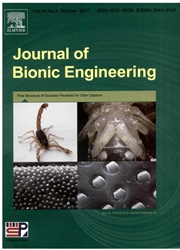

 中文摘要:
中文摘要:
尽管有一个维(1D ) 半导体 nanostructure 数组吸引由于他们的许多增加注意有利,高度订的 TiO 2 nanorod 数组(TiO 2 NR ) 很少在 Ti 底层上在 situ 被种。此处,由使用一个通过面具阳极化过程在 Ti 底层上制作 TiO 2 NR 的一个可行方法被报导。在 Ti 底层上覆盖的自我命令的阳极的铝氧化物(AAO ) 被用作 nanotemplate 导致 TiO 2 NR 的生长。NR 长度和直径能被调整象电气化学的阳极化电压,阳极化时间和温度那样的阳极化参数控制,并且电解质作文。根据建议 NR 形成机制,而且,阳极化的 Ti 离子移居并且在 AAO nanochannels 扔形成 Ti (哦) 在电场下面的 4 或非结晶的 TiO 2 NR,由于模板的监禁效果。Photoelectrochemical 测试显示在加氢以后, TiO 2 NR 在模仿的日光和可见轻照明下面介绍了更高的光电流密度,建议他们在 photoelectrochemical 水切开,光催化,太阳能电池,和传感器的潜在的使用。
 英文摘要:
英文摘要:
Despite one-dimensional (1D) semiconductor nanostructure arrays attracting increasing attention due to their many advantages, highly ordered TiO2 nanorod arrays (TiO2 NR) are rarely grown in situ on Ti substrates. Herein, a feasible method to fabricate TiO2 NRs on Ti substrates by using a through-mask anodization process is reported. Self-ordered anodic aluminum oxide (AAO) overlaid on Ti substrate was used as a nanotemplate to induce the growth of TiO2 NRs. The NR length and diameter could be controlled by adjusting anodization parameters such as electrochemical anodization voltage, anodization time and temperature, and electrolyte composition. Furthermore, according to the proposed NR formation mechanism, the anodized Ti ions migrate and deposit in the AAO nanochannels to form Ti(OH)4 or amorphous TiO2 NRs under electric field, owing to the confinement effect of the template. Photoelectrochemical tests indicated that, after hydrogenation, the TiO2 NRs presented higher photocurrent density under simulated sunlight and visible light illuminations, suggesting their potential use in photoelectrochemical water splitting, photocatalysis, solar cells, and sensors.
 同期刊论文项目
同期刊论文项目
 同项目期刊论文
同项目期刊论文
 期刊信息
期刊信息
